
Lamium amplexicaule, commonly called henbit, is a weedy plant in the mint family (Lamiaceae) related to the ornamental lamiums. Native to Europe, western Asia and northern Africa, it is widespread throughout the US and other parts of the world. The leaves of this and other species are eaten raw or cooked in Europe and Asia but are rarely used as a salad green in this country. This plant is generally found in open areas on waste ground, in lawns, cultivated fields, pastures, along roadsides and railroads, and in other disturbed, unmanaged areas and is a common urban weed in the Midwest.
Henbit is a winter annual or biennial, but can also be a fast-growing, spring-germinating annual.
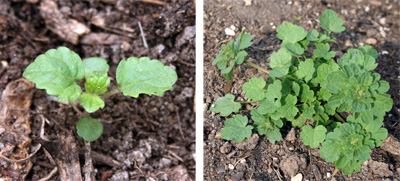
Seedlings have oval cotyledons with smooth edges and hairy stalks. The subsequent true leaves are rounded to heart-shaped with scalloped (round-toothed) or weakly lobed edges and a reticulated appearance because of the depressed veins.
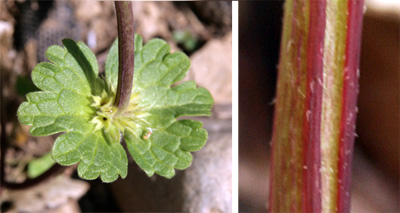
The medium green leaves up to an inch across grow opposite each other on the square stem (typical of plants in the mint family), occurring at intervals along the stems. The upper leaves clasp the stems directly, lacking petioles, while the lower leaves do have long petioles. The upper leaf surface has conspicuous palmate venation and is slightly hairy, and hairs also occur along the veins on the lower surface.
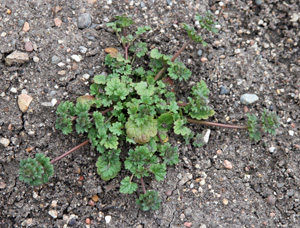
This annual grows from a shallow taproot that becomes finely branched. The low-growing, upright to sprawling plants have a number of weak stems arising from the base that may be erect or lay almost horizontal on the ground. The stems are green but often become purple with age, and may root at the low nodes. The finely hairy stems are covered with downward-pointing hairs. Plants may be 4 to 15 inches tall. They either die after setting seed or go dormant during the hot weather of summer and bloom in the fall.
L. amplexicaule blooms for a month or two in the spring and sometimes in the fall. This plant produces axillary and terminal inflorescences, each with 6-12 sessile flowers. The ½-¾” long, pink to purple flowers are borne in the whorls of the upper leaves (verticillasters). Like most flowers of plants in the mint family, the petals and other parts are fused into a tubular, bilabiate corolla surrounded by the green calyx. The upper lip is hood-like, with a patch of fine hairs on the outside, while the lower lip hangs downward and is divided into two rounded lobes along its outer edge. Flowers are hairy both externally and internally.
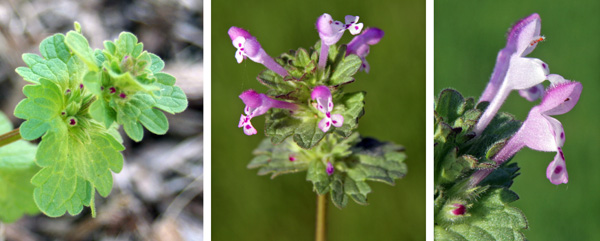
This plant can be an important early-season source of nectar and pollen for honeybees and bumblebees where common; however some plants occasionally produce inconspicuous, self-pollinated flowers that do not open (cleistogamous). The flowers are followed by a fruit composed of four egg-shaped nutlets. These tiny seeds or nutlets are brown with white spots, triangular in cross-section and a little broader and more rounded at one tip than the other.

Henbit grows best in cool, moist areas. It is primarily a problem in open areas of gardens or in weak, thin lawns. It can be discouraged in lawns by maintaining a dense turf through proper mowing and fertilization, and in shaded lawns by growing grass species more adapted to less sun which will better compete with weeds.
This plant propagates primarily by seed, although pieces of the stem can root at the nodes if left on moist soil. In some places, entire fields are washed pink or purple when plants are in bloom. Germination usually occurs in the fall but also happens in spring. Seeds remain viable in the soil for up to five years.
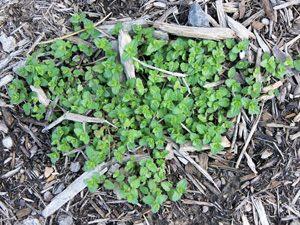
Henbit seeds readily, producing 40-200 seeds per plant, and can spread aggressively, but plants are easy to pull by hand or to hoe out when small. Plants should be removed before they flower and set seed to prevent further infestation. Selective postemergent herbicides can be used in lawns to control henbit but are not recommended as routine lawn maintenance should prevent henbit from becoming a problem. The best control will be achieved if applications are made when henbit is actively growing and in the seedling to flower stage.
Other plants that henbit can be confused with include deadnettles (other Lamium species) and ground ivy or creeping Charlie (Glechoma hederacea). It can be distinguished from the other plants by the leaves: other Lamiums are more erect and their leaves don’t wrap around the stems like those of henbit do, and Gleochoma always has petioles while henbits lacks petioles on the upper leaves (plus this plant has violet-blue or purple rather than pink flowers). Henbit can also be confused with purple deadnettle (Lamium purpureum) which is also a winter annual but has much hairier, more leathery, elongated leaves with a purplish tinge.
– Susan Mahr, University of Wisconsin – Madison
Ask Your Gardening Question
If you’re unable to find the information you need, please submit your gardening question here:





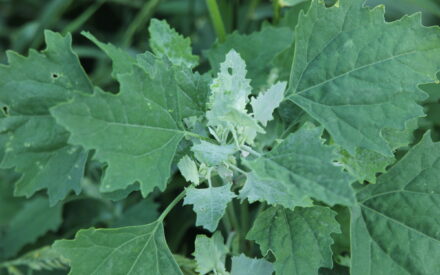 Common Weed Seedlings of the North Central States
Common Weed Seedlings of the North Central States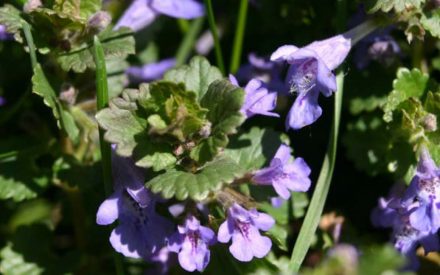 Creeping Charlie
Creeping Charlie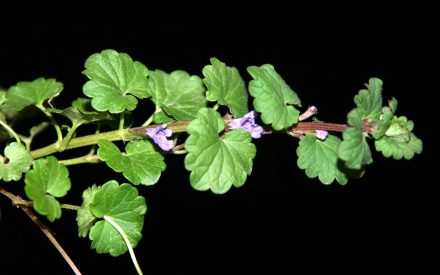 Controlling Creeping Charlie, Gleochoma hederaceae
Controlling Creeping Charlie, Gleochoma hederaceae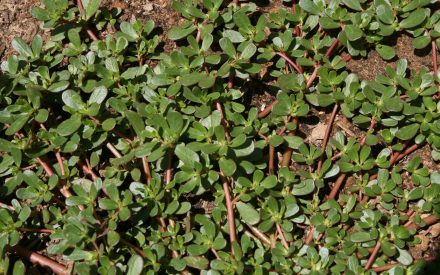 Common Purslane, Portulaca oleracea
Common Purslane, Portulaca oleracea


